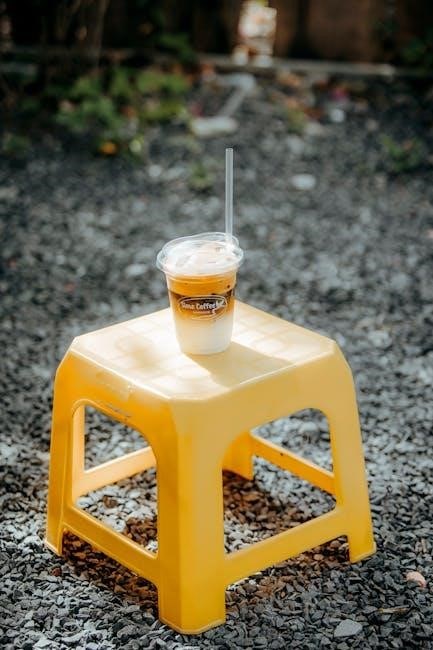The calprotectin stool test is a non-invasive diagnostic tool detecting calprotectin levels in feces, serving as a biomarker for intestinal inflammation and aiding in bowel disease assessment.
1.1 What is the Calprotectin Stool Test?
The calprotectin stool test measures calprotectin, a protein found in stool, which serves as a marker of intestinal inflammation. Elevated levels suggest conditions like inflammatory bowel disease (IBD). This non-invasive test helps diagnose and monitor bowel inflammation without requiring blood draws or invasive procedures. It is often recommended for patients with gastrointestinal symptoms to assess the need for further testing or treatment. The test is straightforward, involving a stool sample collected at home and analyzed in a laboratory.
1.2 Purpose of the Test
The purpose of the calprotectin stool test is to detect and measure calprotectin levels in stool, indicating intestinal inflammation. It helps diagnose conditions like inflammatory bowel disease (IBD) and distinguishes between inflammatory and non-inflammatory bowel disorders. The test is also used to monitor disease activity and treatment response, reducing the need for invasive procedures. By assessing inflammation levels, it guides clinicians in making accurate diagnoses and tailoring management plans for patients with gastrointestinal symptoms.

Importance of the Calprotectin Stool Test
The calprotectin stool test is crucial for detecting intestinal inflammation, aiding in IBD diagnosis, and monitoring treatment without invasive procedures, enhancing patient care and outcomes.
2.1 Role in Diagnosing Bowel Inflammation
The calprotectin stool test plays a vital role in diagnosing bowel inflammation by measuring calprotectin levels, a protein released during intestinal inflammation. Elevated levels indicate conditions like IBD, helping differentiate between inflammatory and non-inflammatory bowel diseases. This non-invasive method reduces the need for endoscopic procedures, providing a reliable and efficient diagnostic tool for gastrointestinal disorders, while also aiding in monitoring disease activity and treatment response effectively.
2.2 Non-Invasive Alternative to Other Tests
The calprotectin stool test offers a non-invasive alternative to procedures like endoscopies or biopsies, making it more comfortable for patients. It eliminates the risks associated with invasive methods, such as bleeding or infection, while still providing accurate insights into bowel inflammation. This test is particularly advantageous for monitoring chronic conditions, reducing patient discomfort and healthcare costs, and expediting diagnosis without compromising accuracy, thus improving overall patient care and satisfaction.

Preparation for the Test
Discuss medications with your physician and avoid discontinuing any without approval. Collect the stool sample using the provided container, ensuring no contamination from urine or water.
3.1 Discussing Medications with Your Physician
Before collecting the stool sample, it is crucial to discuss all medications, including prescription and non-prescription drugs, with your physician. Avoid discontinuing any medications without medical approval, as this may interfere with test results. Certain medications might influence calprotectin levels, so your doctor needs to assess their potential impact on the test’s accuracy. This ensures reliable outcomes and appropriate medical decisions based on your condition;
3.2 Avoiding Contamination of the Sample
To ensure accurate test results, it is essential to avoid contaminating the stool sample. Use plastic wrap or a clean container to collect the stool, avoiding contact with urine, water, or toilet paper. Do not mix the sample with other substances, as this can alter calprotectin levels. Place the stool directly into the provided container, seal it tightly, and wash your hands thoroughly. Proper handling prevents false results and ensures reliable diagnostic outcomes.

Collecting the Stool Sample
Collect the stool sample using the provided container, ideally from your first bowel movement of the day. Avoid mixing with urine or water for accurate results.
4.1 Best Time for Collection
The best time to collect a stool sample is during your first bowel movement of the day. This ensures the sample is fresh and provides accurate test results. Avoid collecting after urination or when the stool has been exposed to water, as this can contaminate the sample and affect the calprotectin levels measured in the test. Consistency in collection timing helps maintain reliability and accuracy in the diagnostic process.
4.2 Using the Provided Container
Use the clean, leak-proof container provided in the collection kit to collect the stool sample. The container typically has a screw-top lid to prevent leakage. Fill the container approximately halfway with stool to ensure an adequate sample size. Avoid overfilling, as this may lead to spillage or contamination. After collecting, tightly seal the container to maintain sample integrity. Label the container with your name, collection date, and time for accurate identification. Do not use household containers unless instructed otherwise. Proper use ensures reliable test results.
4.3 Avoiding Urine and Water Contamination
Prevent urine or water from mixing with the stool sample, as this can contaminate the specimen and affect test accuracy. To avoid this, urinate separately before collecting the stool. When using the toilet, place plastic wrap or a clean container in the bowl to catch the stool, ensuring it doesn’t come into contact with water. Alternatively, collect the stool directly into the provided container without letting it touch the toilet water. Properly seal the container immediately after collection to maintain sample integrity and prevent any accidental contamination.

Handling and Storage of the Sample
After collection, tightly seal the container to prevent leakage. Store the sample at room temperature until submission. Avoid freezing or exposing to extreme heat to preserve accuracy.
5.1 Proper Sealing of the Container
Ensure the stool sample container is tightly sealed to prevent leakage. Screw the lid firmly and double-check for any gaps. Proper sealing maintains sample integrity and avoids contamination.
Keep the container upright during transport to prevent spills. This step is crucial for accurate test results and adheres to laboratory requirements for specimen handling.
5.2 Storage Conditions
Store the stool sample at room temperature (15-30°C) if submitting within 24 hours. If delayed, refrigerate at 2-8°C to preserve integrity. Avoid direct sunlight and heat sources.
Keep the container upright to prevent leakage; Proper storage ensures accurate test results and maintains sample quality for laboratory analysis.
Submitting the Sample
Label the container with your name, collection date, and time. Complete the requisition form accurately, ensuring all required details are included.
Submit the sample promptly to the laboratory. Missing labels or incomplete forms may result in delays or the test not being performed.
6.1 Labeling the Container
Clearly label the stool container with your full name, the date, and time of collection. This ensures accurate identification and avoids mix-ups. Use a permanent marker to write legibly. Make sure the label is waterproof to prevent smudging. Double-check the information for accuracy before submission. Proper labeling is critical for timely and correct processing of your sample in the laboratory.
6.2 Completing the Requisition Form
Fill out the requisition form accurately, including your full name, date of birth, and the date of sample collection. Provide your physician’s name and any relevant medical information. Ensure all fields are completed to avoid delays. Incomplete forms may result in processing delays or the need for resampling. Double-check the information for accuracy before submitting the form with your stool sample. This ensures your test is processed correctly and promptly.

Understanding Test Results
Calprotectin levels indicate intestinal inflammation. Elevated levels suggest inflammatory bowel disease (IBD), while low levels may indicate non-inflammatory conditions like irritable bowel syndrome (IBS). Discuss results with your healthcare provider for proper interpretation and next steps.
7.1 Interpreting Calprotectin Levels
Calprotectin levels in stool help assess intestinal inflammation. Elevated levels (>50 μg/g) suggest active inflammation, often indicating conditions like IBD. Lower levels typically indicate non-inflammatory bowel conditions. Results must be interpreted by a healthcare provider, as reference ranges may vary. Accurate interpretation is crucial for diagnosis and guiding further testing or treatment. Always discuss results with your doctor to understand their implications and determine the next steps in your care plan.
7.2 Follow-Up Actions Based on Results
Depending on calprotectin levels, follow-up actions may vary. High levels may lead to further diagnostic tests like endoscopy or imaging to confirm IBD. Low levels often rule out inflammation, suggesting other causes of symptoms. Your doctor may adjust treatments, monitor symptoms, or recommend lifestyle changes. It’s essential to adhere to the follow-up plan to ensure proper management of your condition and prevent complications. Open communication with your healthcare provider is key to personalized care.

Special Considerations
Special considerations include testing pediatric patients and handling multiple stool samples, requiring careful adherence to instructions to ensure accurate results and proper specimen management.
8.1 Testing in Pediatric Patients
Testing in pediatric patients requires careful guidance, as stool collection may need parental assistance. Use of a clean container is crucial to avoid contamination. Ensure the child’s specimen is collected first thing in the morning, and urine or water must not mix with the stool. Discuss any medications with the physician, as some may affect results. The test’s non-invasive nature makes it ideal for children, helping diagnose conditions like IBD without discomfort.
8.2 Handling Multiple Samples
When handling multiple stool samples, ensure each is properly labeled with the patient’s name, date, and time to avoid mix-ups. Store samples in a cool, dry place until submission. Use separate containers for each sample to prevent cross-contamination. Follow the same collection and storage instructions for each sample, and avoid overfilling containers. Always wash hands before and after handling samples. If submitting multiple samples, keep them organized and ensure all required forms are completed accurately for each test.

Comparison with Other Stool Tests
The calprotectin stool test is more specific for detecting bowel inflammation compared to traditional stool tests, offering a non-invasive alternative to diagnose conditions like IBD effectively.
9.1 Advantages Over Traditional Tests
The calprotectin stool test offers several advantages over traditional methods. It is non-invasive, eliminating the need for uncomfortable procedures like endoscopies or biopsies. The test is highly specific for intestinal inflammation, reducing false positives and providing clearer results. Additionally, it requires minimal sample preparation and can be completed at home, making it more convenient for patients. Its accuracy in detecting conditions like IBD makes it a preferred choice for both diagnosis and monitoring.
9.2 When to Choose Calprotectin Test
The calprotectin stool test is ideal for diagnosing and monitoring inflammatory bowel diseases like Crohn’s and ulcerative colitis. It is recommended when symptoms like abdominal pain, diarrhea, and weight loss persist, suggesting bowel inflammation. The test is also useful for distinguishing between inflammatory and non-inflammatory conditions, such as IBS. It is particularly beneficial for patients who wish to avoid invasive procedures and for monitoring treatment effectiveness over time.

Troubleshooting Common Issues
Common issues include sample contamination, insufficient stool quantity, or delayed testing. Ensure proper sealing, avoid urine/water mix, and follow instructions to prevent errors and retesting.
10.1 Dealing with Insufficient Sample
If the stool sample is insufficient, it may lead to inaccurate results. To avoid this, use the provided container and scoop as instructed. Collect enough stool to fill the container to the recommended level, typically about 1-2 teaspoons. Avoid mixing stool with urine or water, as this can contaminate the sample. If the sample is too small, consult your healthcare provider or the lab for guidance on redoing the test. Ensure proper sealing and labeling to prevent issues. Contact the lab if the sample is deemed insufficient. Follow all instructions carefully to ensure accurate testing.
10.2 Resolving Contamination Problems
Contamination of the stool sample can occur from urine, water, or toilet paper. To resolve this, ensure the sample is collected directly into the provided container without touching any contaminated surfaces. If contamination occurs, discard the sample and restart using a new container. Wash your hands thoroughly before and after handling the sample. Properly seal the container and label it to avoid mix-ups. Contact your healthcare provider or the lab if contamination issues persist. Always follow the instructions carefully for accurate test results.
The calprotectin stool test is a non-invasive method to diagnose and monitor bowel inflammation, ensuring accurate results when instructions are followed carefully.
11.1 Summary of Key Points
The calprotectin stool test is a non-invasive method to detect bowel inflammation by measuring calprotectin levels in stool. It aids in diagnosing conditions like IBD and reduces the need for invasive procedures. Proper preparation, including discussing medications and avoiding contamination, is essential for accurate results. Following collection and storage instructions ensures reliable outcomes. This test provides valuable insights into gastrointestinal health, helping guide treatment decisions and monitor disease activity effectively.
11.2 Final Tips for Patients
Always follow the provided instructions carefully to ensure accurate test results. Discuss medications with your physician before sample collection. Collect the stool sample in the morning for best results. Avoid contamination with urine or water. Label the container clearly with your name, date, and time. Store the sample properly and deliver it to the lab promptly. Keep the test kit and instructions handy for reference. Adhere to all guidelines to avoid retesting and ensure reliable outcomes.

References and Further Reading
For detailed guides, visit www.interiorhealth.ca or www.albertahealthservices.ca. Additional resources are available at percuro.ca for comprehensive instructions.
12.1 Recommended Resources
For comprehensive instructions, visit www.interiorhealth.ca or www.albertahealthservices.ca. Additional guides are available at percuro.ca, offering detailed protocols. These resources provide step-by-step directions and troubleshooting tips for patients. They also include downloadable PDFs and FAQs to address common questions. Ensure to review these materials before collecting your sample for accurate test results. Proper preparation is key to obtaining reliable outcomes.
12.2 Links to Detailed Guides
Access detailed instructions at www.interiorhealth.ca and www.albertahealthservices.ca. These sites offer downloadable PDF guides, step-by-step videos, and FAQ sections. For additional support, visit percuro.ca, which provides visual aids and troubleshooting tips. These resources cover sample collection, handling, and storage, ensuring accurate test results. Utilize these guides to understand the process thoroughly and avoid common mistakes during your calprotectin stool test preparation.
